Moso Bamboo Invasion Enhances Soil Infiltration and Water Flow Connectivity in Subtropical Forest Root Zones: Mechanisms and Implications
Abstract
1. Introduction
2. Materials and Methods
2.1. Study Area
2.2. Plot Setting and Survey
2.3. Soil Infiltration Capacity and Water Flow Connectivity Measurement
2.4. Soil Sample and Root Determination
2.5. Calculation of Soil Infiltration Rate and Water Flow Connectivity
2.5.1. Calculation of the Soil Infiltration Rate
2.5.2. Calculation of Water Flow Connectivity Index
2.6. Statistical Analysis
3. Results
3.1. Soil Infiltration Capacity and Water Flow Connectivity in Different Moso Bamboo Invasion Stages
3.2. Soil Properties and Root Characteristics in Different Moso Bamboo Invasion Stages
3.3. Relationship Between Soil Properties and Root Characteristics
3.4. Factors Influencing Infiltration Capacity and Water Flow Connectivity
4. Discussion
4.1. Effects of Moso Bamboo Invasion on Root Characteristics and Soil Properties
4.2. Effects of Moso Bamboo Invasion on Soil Infiltration Capacity and Water Flow Connectivity
4.3. Limitations and Implications of the Study
5. Conclusions
Author Contributions
Funding
Data Availability Statement
Acknowledgments
Conflicts of Interest
References
- Landhausser, S.M.; Deshaies, D.; Lieffers, V.J. Disturbance facilitates rapid range expansion of aspen into higher elevations of the Rocky Mountains under a warming climate. J. Biogeogr. 2010, 37, 68–76. [Google Scholar] [CrossRef]
- Davies, K.W. Exotic plants increase and native plants decrease with loss of foundation species in sagebrush steppe. Oecologia 2011, 167, 481–491. [Google Scholar] [CrossRef]
- Cleland, E.; Larios, L.; Suding, K. Strengthening invasion filters to reassemble native plant communities: Soil resources and phenological overlap. Restor. Ecol. 2013, 21, 390–398. [Google Scholar] [CrossRef]
- Liu, J.; Yang, Q.; Song, Q.; Yu, D.; Yang, G.; Qi, H.; Shi, J. Strategy of fine root expansion of Phyllostachys pubescens population into evergreen broad- leaved forest. Chin. J. Plant Ecol. 2013, 37, 230–238. [Google Scholar] [CrossRef]
- Li, Y.; Feng, P. Bamboo resources in China based on the ninth National Forest Inventory Data. World Bamboo Rattan. 2019, 17, 45–48. [Google Scholar]
- Suzuki, S.; Nakagoshi, N. Expansion of bamboo forests caused by reduced bamboo-shoot harvest under different natural and artificial conditions. Ecol. Res. 2008, 23, 641–647. [Google Scholar] [CrossRef]
- Fang, H.; Liu, Y.; Bai, J.; Li, A.; Deng, W.; Bai, T.; Liu, X.; Lai, M.; Feng, Y.; Zhang, J.; et al. Impact of Moso bamboo (Phyllostachys edulis) expansion into Japanese cedar plantations on soil fungal and bacterial community compositions. Forests 2022, 13, 1190. [Google Scholar] [CrossRef]
- Liu, Y.; Zhang, Z.; Liu, Y.; Cui, Z.; Leite, P.; Shi, J.; Wu, G. Shrub encroachment enhances the infiltration capacity of alpine meadows by changing the community composition and soil conditions. Catena 2022, 213, 106222. [Google Scholar] [CrossRef]
- Beven, K. A Century of Denial: Preferential and Nonequilibrium Water Flow in Soils, 1864–1984. Vadose Zone J. 2018, 17, 180153. [Google Scholar] [CrossRef]
- Qiu, D.X.; Xu, R.; Gao, P. Effect of vegetation restoration type and topography on soil water storage and infiltration capacity in the Loess Plateau, China. Catena 2024, 241, 108079. [Google Scholar] [CrossRef]
- Wang, D.; Chen, J.; Tang, Z. Effects of Soil Physical Properties on Soil Infiltration in Forest Ecosystems of Southeast China. Forests 2024, 15, 1470. [Google Scholar] [CrossRef]
- Gan, F.; Shi, H.; Gou, J.; Zhang, L.; Liu, C. Effects of bedrock strata dip on soil infiltration capacity under different land use types in a karst trough valley of Southwest China. Catena 2023, 230, 107253. [Google Scholar] [CrossRef]
- Cai, L.; Wang, F.; Lin, Y.; Qi, L.Q.; Zhao, Y.; Han, J.; Chen, H. Changes in preferential flow caused by root effects in black locust plantations of different stand ages in the semi-arid region of the Loess Plateau. J. Hydrol. 2024, 634, 131086. [Google Scholar] [CrossRef]
- Wang, D.; Niu, J.; Dai, Z.; Yang, T.; Miao, Y.; Zhang, L.; Chen, X.; Ronny, B. Forest restoration effects on soil preferential flow in the paleo-periglacial eastern Liaoning mountainous regions, China. J. Clean. Prod. 2024, 467, 142974. [Google Scholar] [CrossRef]
- Basset, C.; Abou, N.M.; Ghezzehei, T.; Hao, X.X.; Daccache, A. How does soil structure affect water infiltration? A meta-data systematic review. Soil. Tillage Res. 2023, 226, 105577. [Google Scholar] [CrossRef]
- Wang, P.; Liu, Q.; Zhou, Z.; Liu, J.; Cao, L.; Wang, N.; Cao, Y. Distinct variations of soil infiltrability of contrasting root types in a temperate mosaic-pattern grassland in northern China. Catena 2024, 243, 108174. [Google Scholar] [CrossRef]
- Cui, Z.; Huang, Z.; Liu, Y.; López, V.M.; Wu, G. Natural compensation mechanism of soil water infiltration through decayed roots in semi-arid vegetation species. Sci. Total Environ. 2021, 819, 151985. [Google Scholar] [CrossRef] [PubMed]
- Dai, Y.; Guo, J.; Li, Y.; Dong, Z.; Li, H. Soil physical and chemical properties affected by long-term grazing on the desert steppe of Inner Mongolia, China. Catena 2022, 211, 105996. [Google Scholar] [CrossRef]
- Yang, L.; Dong, L.; Li, A.; Lv, W.; Wu, J.; Zhang, H.; Deng, L. Soil physicochemical properties and crusts regulate the soil infiltration capacity after land-use conversions from farmlands in semiarid areas. J. Hydrol. 2023, 626, 130283. [Google Scholar] [CrossRef]
- Hou, F.; Cheng, J.; Zhang, H.; Wang, X.; Shi, D.; Guan, N. Response of preferential flow to soil−root−rock fragment system in karst rocky desertification areas. Ecol. Indic. 2024, 165, 112234. [Google Scholar] [CrossRef]
- Zhu, P.; Zhang, G.; Wang, H.; Xing, S. Soil infiltration properties affected by typical plant communities on steep gully slopes on the Loess Plateau of China. J. Hydrol. 2020, 590, 125535. [Google Scholar] [CrossRef]
- Lukáš, J.; Alena, W.; Martin, K. Effects of different tree species on infiltration and preferential flow in soils developing at a clayey spoil heap. Geoderma 2021, 403, 115372. [Google Scholar] [CrossRef]
- Zhang, W.; Zhu, X.; Xiong, X.; Wu, T.; Zhou, S.; Lie, Z.; Liu, J. Changes in soil infiltration and water flow paths: Insights from subtropical forest succession sequence. Catena 2023, 221, 106748. [Google Scholar] [CrossRef]
- Tian, X.; Wu, W.; Zeng, S.; Li, Y.; Jiang, Y. Differences in soil water movement between the dip and anti-dip slopes of a karst trough valley. J. Hydrol. 2024, 636, 131246. [Google Scholar] [CrossRef]
- Guan, N.; Cheng, J.; Bi, H. Laboratory and field characterization of preferential flow under consideration of geometric fracture features in a karst region in southwest China. J. Hydrol. 2024, 631, 130851. [Google Scholar] [CrossRef]
- Germann, P.F. Viscosity—The weak link between Darcy’s law and Richards’ capillary flow. Hydrol. Processes 2018, 32, 1166–1172. [Google Scholar] [CrossRef]
- Zhang, J.; Sun, Q.; Wen, N.; Horton, R.; Liu, G. Quantifying preferential flows on two farmlands in the North China plain using dual infiltration and dye tracer methods. Geoderma 2022, 428, 116205. [Google Scholar] [CrossRef]
- Zhang, W.; Wang, L.; Tang, Z.; Zhang, Y. Effects of the Root System Architecture of Pinus taeda and Phyllostachys edulis on the Index of Hydrological Connectivity in Subtropical Forest Ecosystems. Forests 2022, 13, 2008. [Google Scholar] [CrossRef]
- Qiu, D.; Xu, R.; Wu, C.; Mu, X.; Zhao, G.; Gao, P. Effects of vegetation restoration on soil infiltrability and preferential flow in hilly gully areas of the Loess Plateau, China. Catena 2023, 211, 106770. [Google Scholar] [CrossRef]
- Tang, Z.; Zhang, W.; Chen, J.; Wang, L.; Zhang, Y. Contributions of soil organic carbon-induced root- and soil properties complexity to water flow in eastern China. Sci. Total Environ. 2024, 945, 174125. [Google Scholar] [CrossRef]
- Liu, X.; Siemann, E.; Cui, C.; Liu, Y.; Guo, X.; Zhang, L. Moso bamboo (Phyllostachys edulis) invasion effects on litter, soil and microbial PLFA characteristics depend on sites and invaded forests. Plant Soil. 2019, 439, 85–99. [Google Scholar] [CrossRef]
- Fukushima, K.; Usui, N.; Ogawa, R.; Tokuchi, N. Impacts of Moso bamboo (Phyllostachys pubescens) invasion on dry matter and carbon and nitrogen stocks in a broad-leaved secondary forest located in Kyoto, western Japan: Bamboo invasion impacts C and N stocks. Plant Spec. Biol. 2015, 30, 81–95. [Google Scholar] [CrossRef]
- Li, Y.; Li, Y.; Chang, S.; Xu, Q.; Guo, Z.; Gao, Q.; Qin, Z.; Yang, Y.; Chen, J.; Liang, X. Bamboo invasion of broadleaf forests altered soil fungal community closely linked to changes in soil organic C chemical composition and mineral N production. Plant Soil. 2017, 418, 507–521. [Google Scholar] [CrossRef]
- Zhao, M.; Huang, Y.; Lei, T.; Deng, Y.; Yang, G.; Ban, Y.; Huang, Y. Changes of preferential flow in short-rotation eucalyptus plantations: Field experiments and modeling. J. Hydrol. 2023, 622, 129663. [Google Scholar] [CrossRef]
- Zhang, Y.; Chen, J.; Zhang, J.; Zhang, Z.; Zhang, M. Novel indicator for assessing wetland degradation based on the index of hydrological connectivity and its correlation with the root-soil interface. Ecol. Indic. 2021, 133, 108392. [Google Scholar] [CrossRef]
- Zhang, Y.; Tang, Z.; Zhang, J.; Zhang, Z.; Zhang, M. Visualizing preferential flow paths using dye tracer and species diversity theory methods to explore their correlation to soil properties with random forest algorithm. J. Hydrol. 2024, 368, 131570. [Google Scholar] [CrossRef]
- Cai, C.; Fan, S.; Liu, X. Fine root adaptation strategies during the expansion of Moso bamboo to Chinese fir forest. Chin. J. Ecol. 2019, 38, 967–972. [Google Scholar]
- Song, Q.; Yang, Q.; Liu, J. Effects of bamboo expansion on soil nitrogen mineralization and availability in evergreen broad-leaved forest. hin. J. Appl. Ecol. 2013, 24, 338–344. [Google Scholar]
- Xu, D.; Liu, J.; He, Z. Community species diversity characteristics of Phyllostachys heterocycla after expansion into Cunninghamia lanceolata forest. J. For. Environ. 2019, 39, 7–41. [Google Scholar]
- Wu, J.; Jiang, P.; Wang, Z. Effects of bamboo expansion on soil fertility in Tianmu Mountain National Nature Reserve. Acta Agric. Univ. Jiangxi. 2008, 4, 4689–4692. [Google Scholar]
- Xie, Y.; Guo, Z.; Lin, S. Soil particle composition and water infiltration characteristics during the succession of understory vegetation in Moso bamboo forest. J. Nanjing For. Univ. 2024, 48, 108–116. (In Chinese) [Google Scholar]
- Wilcox, P.; Caldeira, C.; Leite, A. Understory shrubs improve soil infiltrability in overgrazed Mediterranean oak woodlands, but have little impact on ungrazed woodlands. For. Ecol. Manag. 2024, 26, 122186. [Google Scholar] [CrossRef]
- Lu, S.; Liu, M.; Yi, J. Lateral partition patterns and controlling factors of soil infiltration at a steep, near-stream, and humid hillslope scale. Catena 2024, 239, 107917. [Google Scholar] [CrossRef]
- Peng, J.; Wu, Y.; Geng, T. Soil pore dynamics and infiltration characteristics as affected by cultivation duration for Mollisol in northeast China. Geoderma 2024, 449, 117021. [Google Scholar] [CrossRef]
- Huang, Y.; Xiong, T.; Zhao, M.; Deng, Y.; Yang, G.; Ban, Y.; Huang, Y. Influence of soil properties and near-surface roots on soil infiltration process in short-rotation eucalyptus plantations in southern subtropical China. Catena 2024, 234, 107606. [Google Scholar] [CrossRef]
- Shi, X.; Qin, T.; Yan, D.; Tian, F.; Wang, H. A meta-analysis on effects of root development on soil hydraulic properties. Geoderma 2021, 403, 115363. [Google Scholar] [CrossRef]
- Wang, D.; Niu, J.; Tao, Y. Soil water infiltration characteristics of reforested areas in the paleo-periglacial eastern Liaoning mountainous regions, China. Catena 2024, 234, 107613. [Google Scholar] [CrossRef]
- Wei, H.; Yang, Y.; Wang, J.; Meng, Q.; Deng, Y. A comparison of preferential flow characteristics and influencing factors between two soils developed in the karst region of Southwest China. Soil. Tillage Res. 2024, 241, 106132. [Google Scholar] [CrossRef]
- Robinson, D.A.; Nemes, A.; Reinsch, S.; Radbourne, A.; Bentley, L.; Keith, A.M. Global meta-analysis of soil hydraulic properties on the same soils with differing land use. Sci. Total Environ. 2022, 852, 158506. [Google Scholar] [CrossRef]
- Su, L.; Yang, Y.; Li, X.; Wang, D.; Liu, Y.; Liu, Y.; Li, M. Increasing plant diversity and forb ratio during the revegetation processes of trampled areas and trails enhances soil infiltration. Land. Degrad. Dev. 2018, 29, 4025–4034. [Google Scholar] [CrossRef]
- Dai, L.; Zhang, Y.; Liu, Y.; Xie, L.; Zhao, S.; Zhang, Z.; Lv, X. Assessing hydrological connectivity of wetlands by dye-tracing experiment. Ecol. Indic. 2020, 119, 106840. [Google Scholar] [CrossRef]
- Tang, Z.; Zhang, W.; Chen, J.; Zhang, Y. Soil quality assessment and its response to water flow connectivity in different vegetation restoration types, eastern China. Catena 2024, 247, 108477. [Google Scholar] [CrossRef]
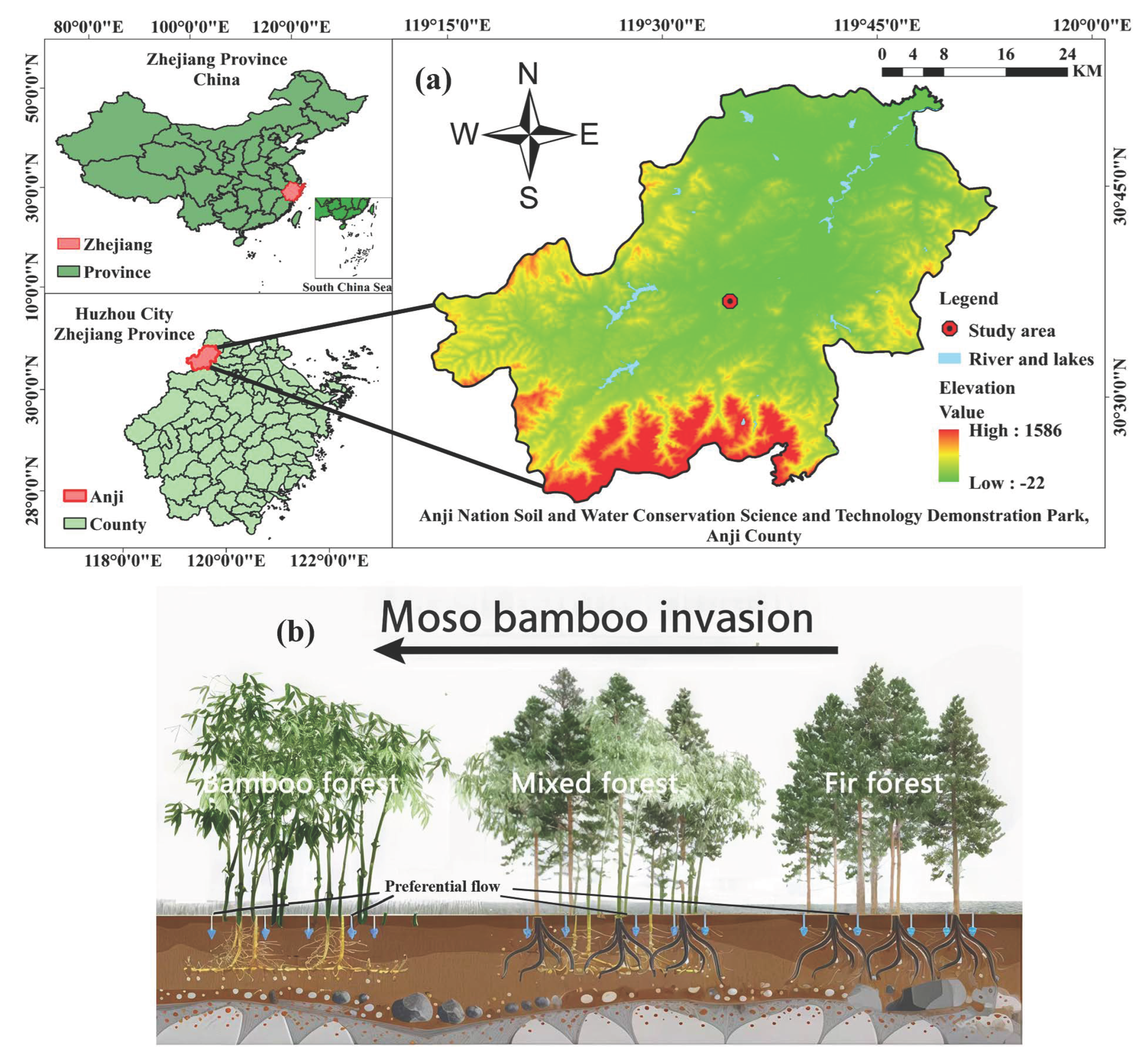
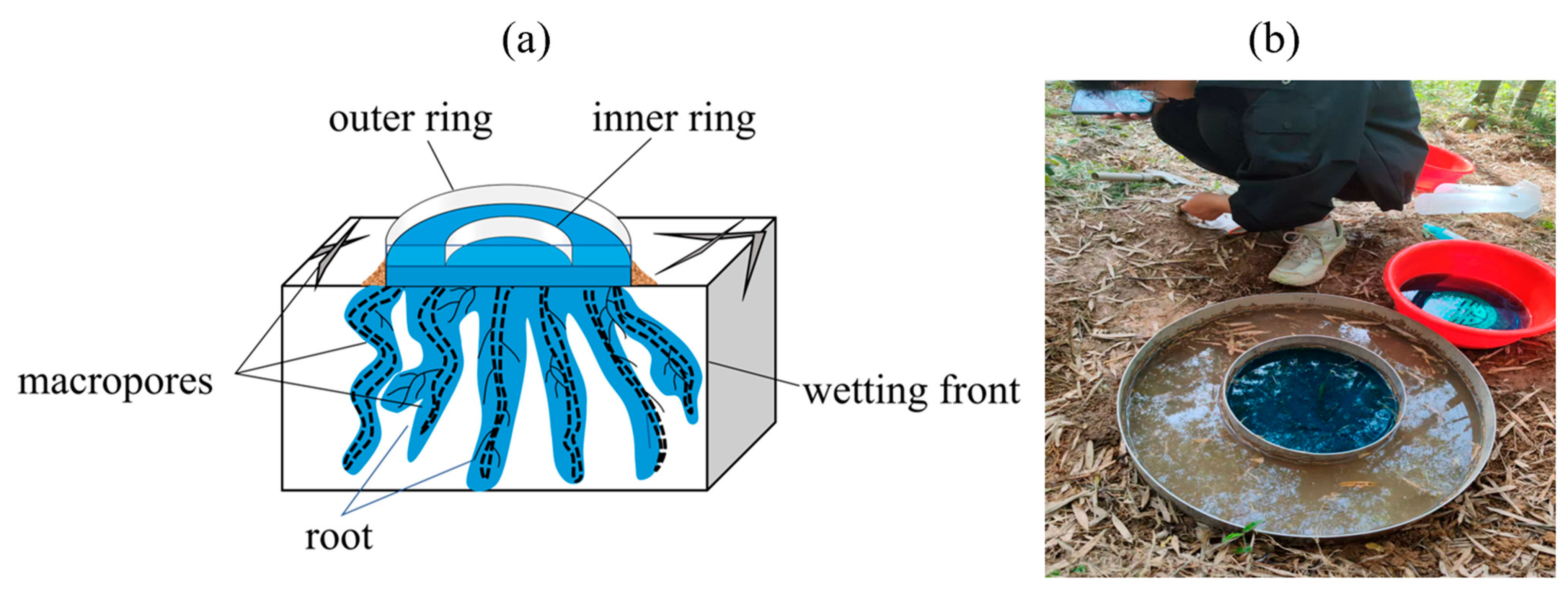
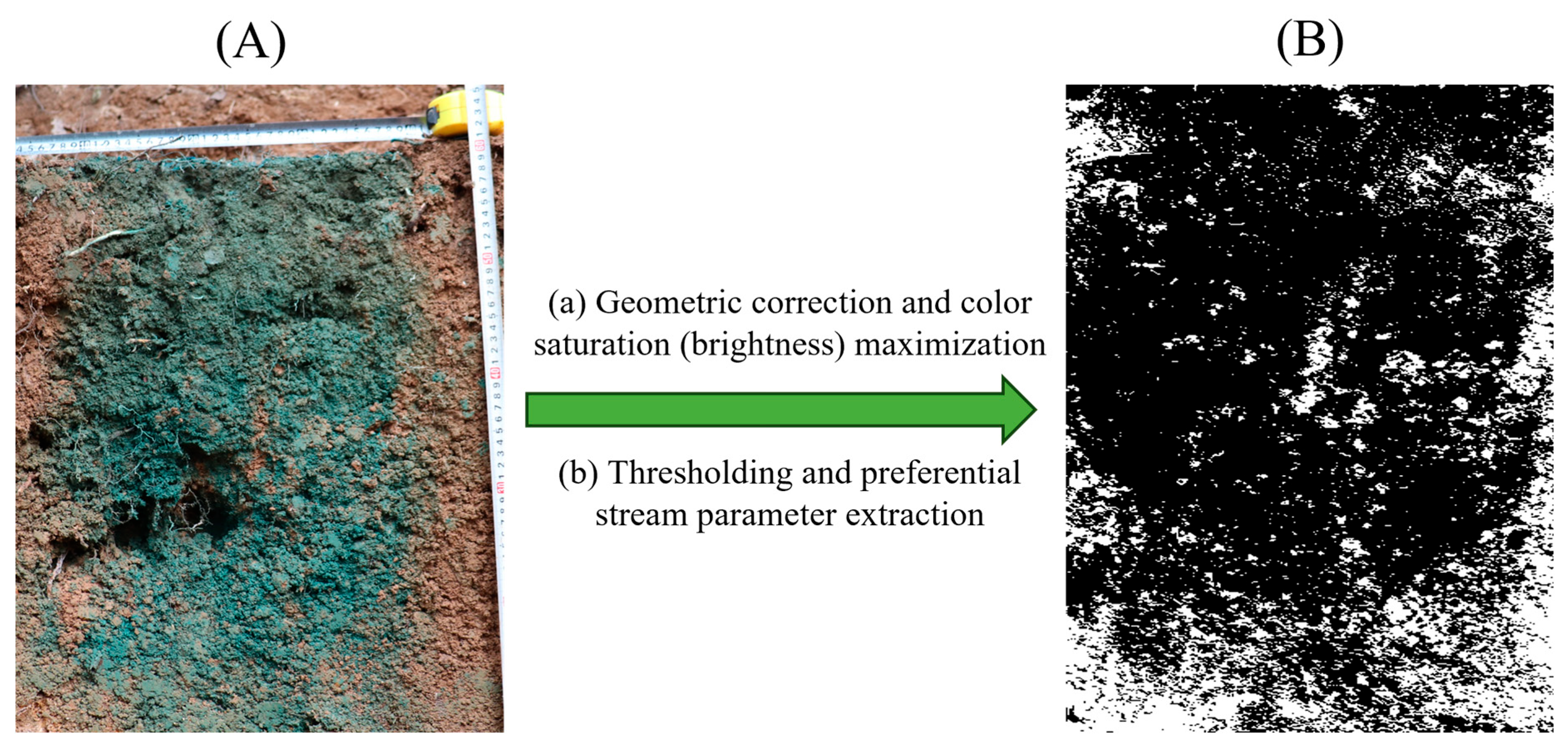

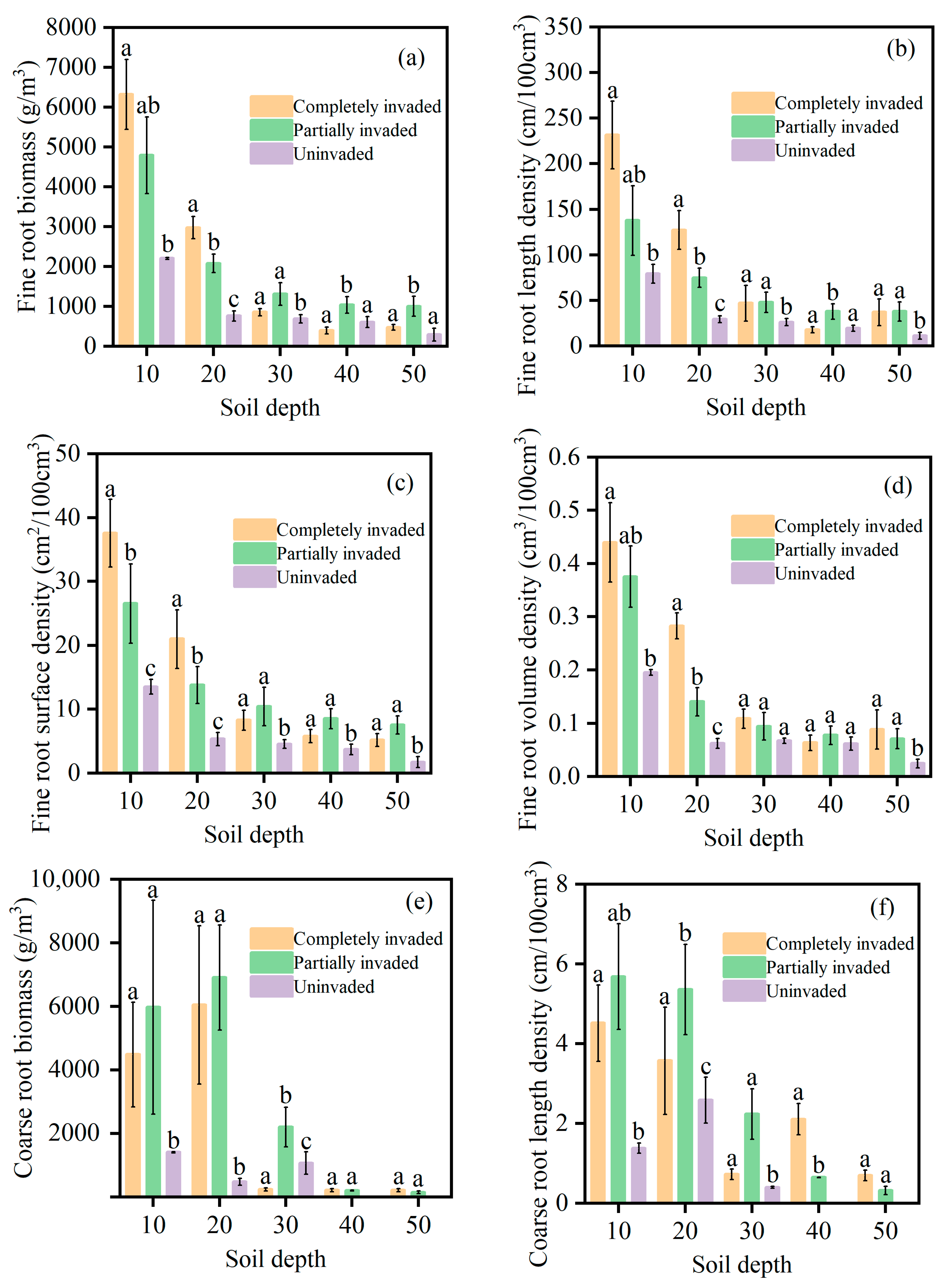
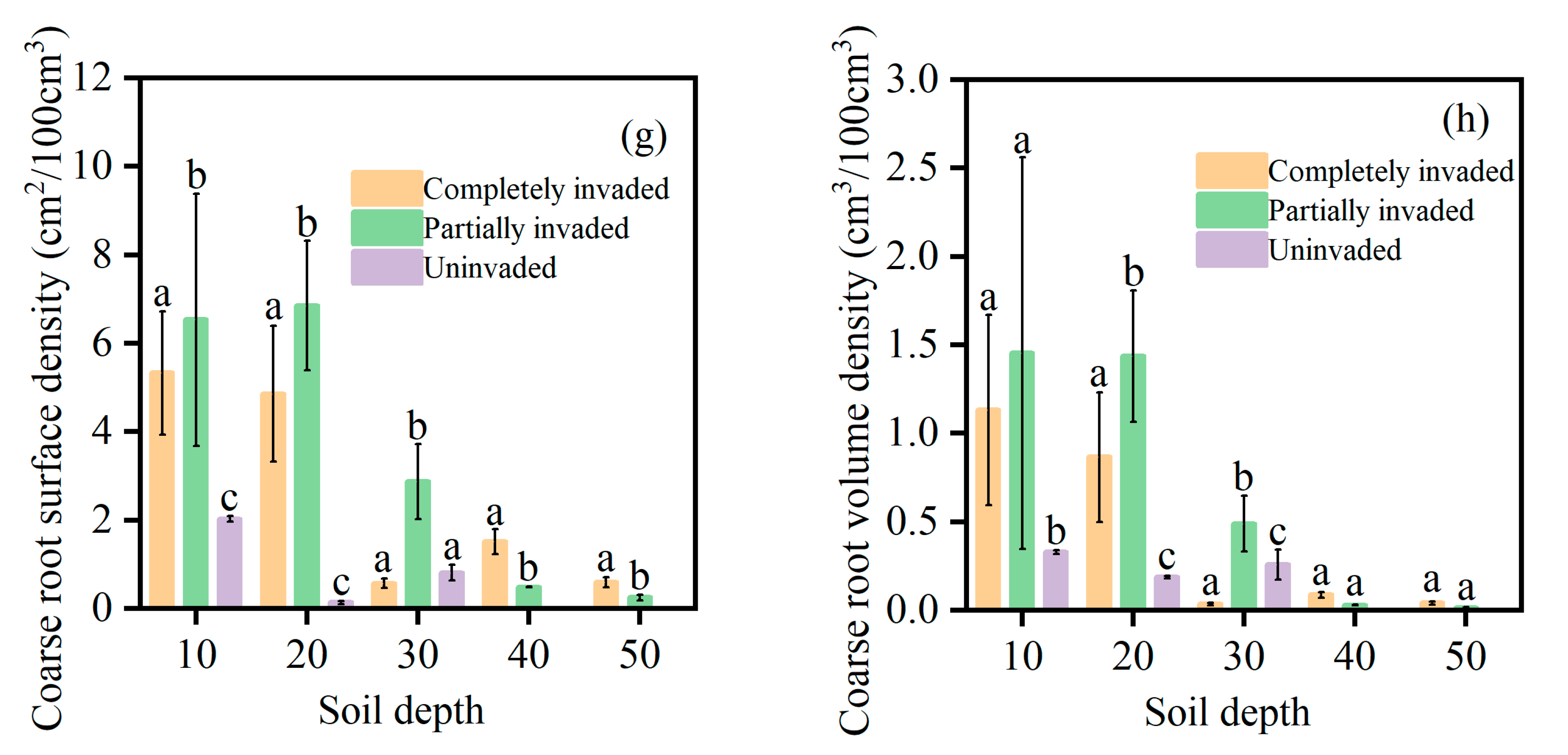

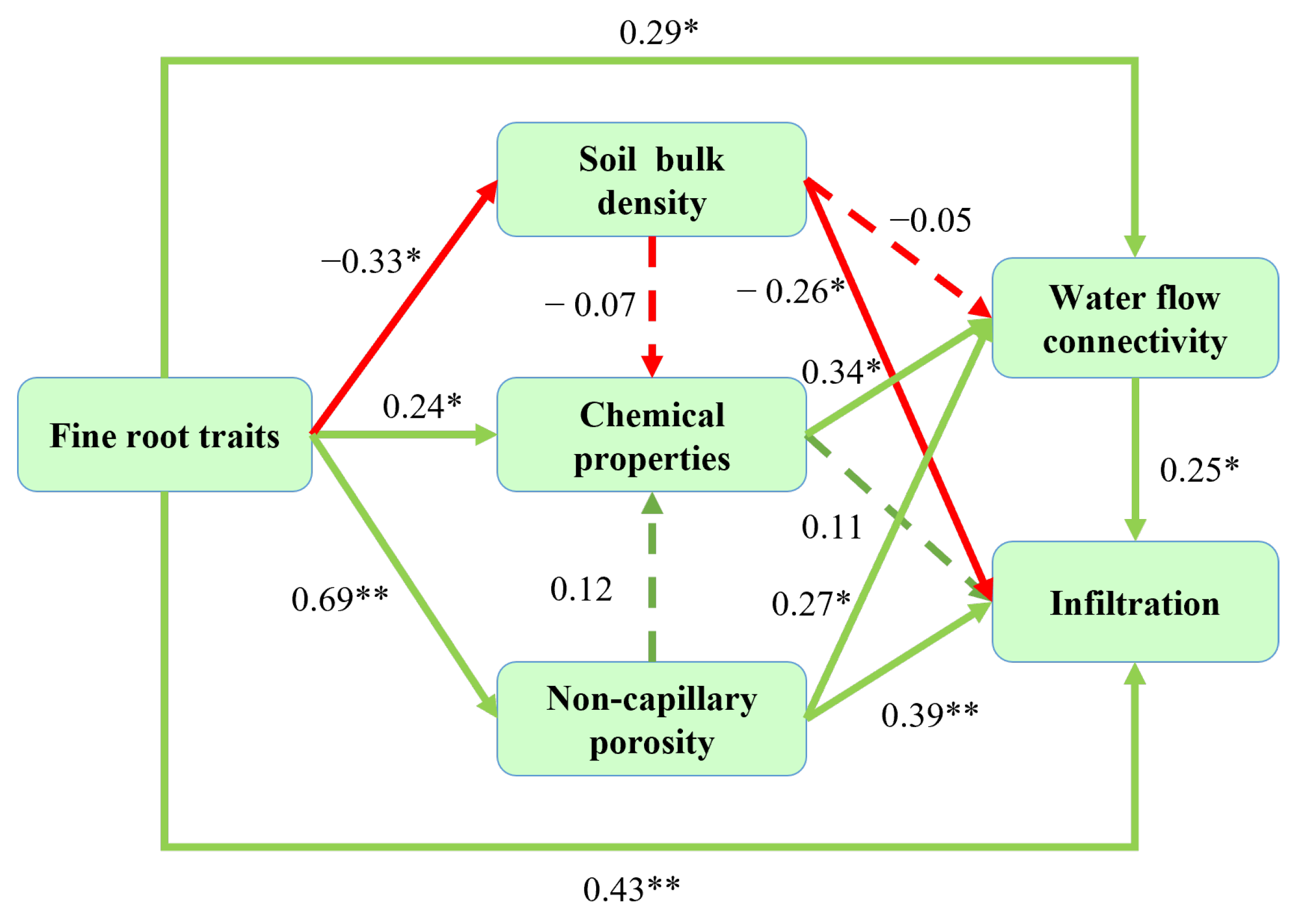
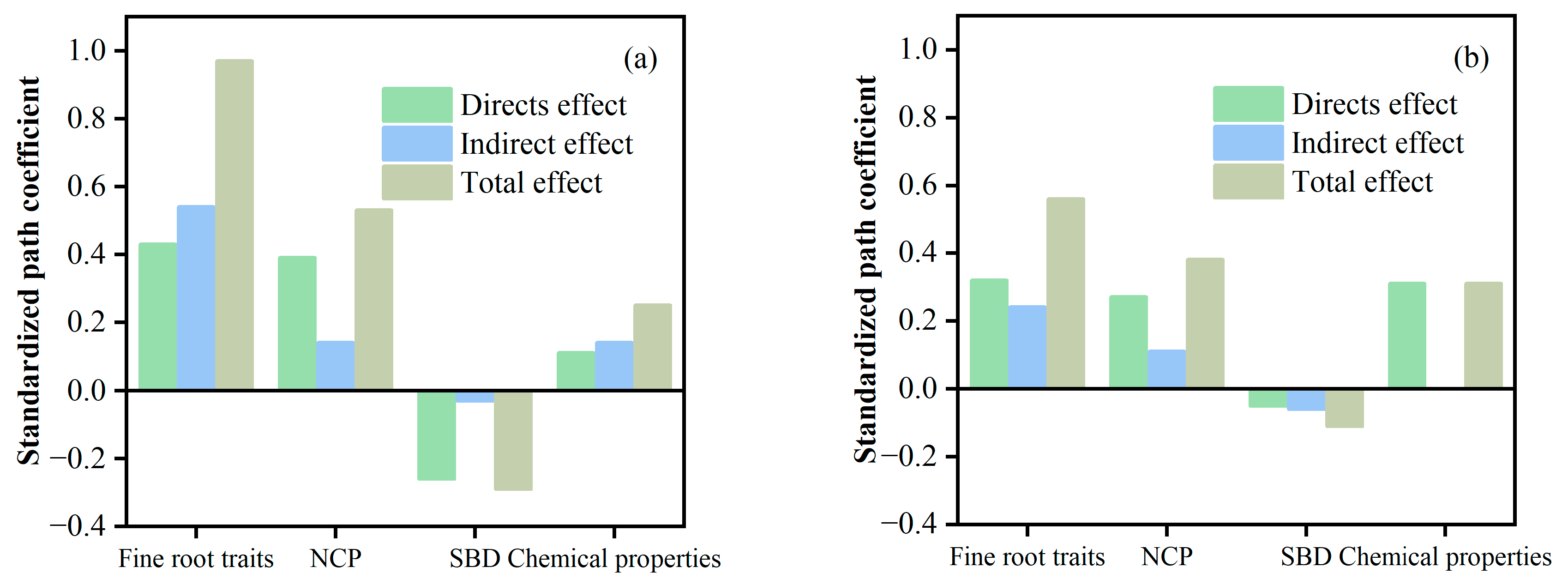
| Invasion Stages | Main Vegetation | Elevation (m) | Slope | Stand Density (plants/hm2) | Canopy Density (%) |
|---|---|---|---|---|---|
| Uninvaded | Cunninghamia lanceolata | 73 | 8 | 1875 | 73 |
| Partial invaded | Cunninghamia lanceolata | 74 | 9 | 1350 | 71 |
| Phyllostachys edulis | |||||
| Completely invaded | Phyllostachys edulis | 74 | 8 | 1050 | 65 |
| Abbreviation | Meaning | Abbreviation | Meaning |
|---|---|---|---|
| RBD1 | Fine root biomass | RBD2 | Coarse root biomass |
| RLD1 | Fine root length density | RLD2 | Coarse root length density |
| RSAD1 | Fine root surface area density | RSAD2 | Coarse root surface area density |
| RVD1 | Fine root volume density | RVD2 | Coarse root volume density |
| SBD | Soil bulk density | TP | Total porosity |
| CP | Capillary pores | NCP | Non-capillary pores |
| SOC | Soil organic carbon | TN | Total nitrogen |
| Soil Depth (cm) | Invasion Stages | SBD | TP | CP | NCP | SOC | pH | TN | Sand | Silt | Clay |
|---|---|---|---|---|---|---|---|---|---|---|---|
| 0–10 | Completely invaded | 1.11 ± 0.08 a | 49.11 ± 3.47 a | 38.64 ± 2.25 a | 10.47 ± 2.02 a | 29.02 ± 4.05 a | 4.91 ± 0.37 a | 2.46 ± 0.28 a | 69 ± 4.21 a | 19.94 ± 2.8 a | 11.07 ± 1.85 ab |
| Partially invaded | 1.19 ± 0.03 a | 42.82 ± 4.71 b | 21.32 ± 14.25 b | 8.72 ± 0.99 ab | 22.54 ± 2.03 a | 4.44 ± 0.46 ab | 1.71 ± 0.31 a | 65.03 ± 6.43 a | 21.29 ± 6.18 a | 13.69 ± 2.86 a | |
| Uninvaded | 1.2 ± 0.05 a | 48.12 ± 3.26 ab | 40.78 ± 4.05 a | 7.34 ± 0.83 b | 28.22 ± 15.21 a | 4.28 ± 0.1 b | 1.64 ± 0.78 a | 69.66 ± 2.69 a | 20.47 ± 2.82 a | 9.88 ± 0.83 b | |
| 10–20 | Completely invaded | 1.28 ± 0.06 b | 42.43 ± 2.15 a | 35 ± 1.25 a | 7.43 ± 1.03 a | 17.7 ± 3.4 a | 4.78 ± 0.1 a | 1.32 ± 0.32 a | 62.81 ± 11.5 a | 23.31 ± 11.8 a | 13.88 ± 2.08 a |
| Partially invaded | 1.41 ± 0.06 b | 44.04 ± 5.54 a | 37.66 ± 5.63 b | 6.38 ± 0.09 b | 13.77 ± 3.35 a | 4.75 ± 0.18 a | 0.91 ± 0.21 a | 64.73 ± 2.55 a | 23.34 ± 2.15 b | 11.92 ± 3.54 b | |
| Uninvaded | 1.46 ± 0.02 a | 44.79 ± 2.09 a | 38.89 ± 2.03 a | 5.9 ± 0.06 c | 12.79 ± 0.6 b | 4.96 ± 0.23 a | 0.84 ± 0.04 b | 62.57 ± 3 b | 26.41 ± 4.64 ab | 11.03 ± 2.04 b | |
| 20–30 | Completely invaded | 1.27 ± 0.01 b | 39.89 ± 4.1 a | 31.87 ± 2.97 a | 5.82 ± 1.87 a | 11.19 ± 1.32 a | 5.17 ± 0.27 a | 0.9 ± 0.25 a | 56.91 ± 8.27 a | 31.52 ± 6.78 a | 11.57 ± 3.44 a |
| Partially invaded | 1.33 ± 0.02 b | 39.63 ± 2.84 a | 27.95 ± 11.2 b | 7.27 ± 0.8 b | 11.08 ± 1.76 a | 5.2 ± 0.18 b | 0.77 ± 0.19 b | 60.81 ± 6.69 b | 26.25 ± 8.54 b | 12.94 ± 2.12 b | |
| Uninvaded | 1.47 ± 0.1 a | 44.19 ± 3.27 a | 37.52 ± 3.3 ab | 6.66 ± 0.11 b | 8.42 ± 4.51 a | 5.2 ± 0.1 b | 0.62 ± 0.21 b | 59.62 ± 5.02 b | 26.47 ± 5.42 b | 13.92 ± 0.83 b | |
| 30–40 | Completely invaded | 1.37 ± 0.03 a | 42.14 ± 3.29 a | 37.59 ± 3.36 a | 4.56 ± 0.7 a | 7.35 ± 1.55 a | 5.43 ± 0.34 a | 0.53 ± 0.09 a | 40.89 ± 7.81 a | 49.3 ± 3.52 a | 9.81 ± 4.83 a |
| Partially invaded | 1.39 ± 0.02 b | 36.46 ± 2.71 a | 31.03 ± 2.42 ab | 5.43 ± 0.43 b | 6.68 ± 1.12 b | 5.24 ± 0.3 a | 0.48 ± 0.07 a | 44.05 ± 10.68 ab | 40.37 ± 10.56 b | 15.58 ± 1.2 b | |
| Uninvaded | 1.45 ± 0.01 a | 39.69 ± 2.92 b | 34.43 ± 2.83 b | 5.26 ± 0.48 c | 7.65 ± 0.74 ab | 5.49 ± 0.18 a | 0.57 ± 0.07 a | 50.09 ± 1.06 b | 38.04 ± 2 b | 11.87 ± 2.1 b | |
| 40–50 | Completely invaded | 1.33 ± 0.06 a | 40.4 ± 1.32 a | 34.53 ± 0.93 a | 5.86 ± 0.45 a | 4.4 ± 1.01 a | 5.06 ± 0.06 a | 0.28 ± 0.06 a | 19.22 ± 5.5 a | 68.64 ± 5.26 a | 12.14 ± 0.88 a |
| Partially invaded | 1.47 ± 0.07 b | 38.7 ± 2.01 a | 33.05 ± 1.74 b | 5.66 ± 1.08 b | 6.39 ± 1.53 b | 5.26 ± 0.06 a | 0.46 ± 0.07 b | 16.37 ± 1.02 b | 68.57 ± 1.47 b | 15.05 ± 0.55 b | |
| Uninvaded | 1.47 ± 0.01 a | 38.29 ± 0.88 a | 32.54 ± 0.99 b | 5.74 ± 0.53 b | 8.52 ± 1.61 a | 5.38 ± 0.1 b | 0.59 ± 0.06 a | 13.02 ± 4.31 b | 70.91 ± 3.29 b | 16.08 ± 1.11 b |
| Root Index | Soil Physical Index | Soil Chemical Index | Soil Texture | ||||||||
|---|---|---|---|---|---|---|---|---|---|---|---|
| W | SBD | TP | CP | NCP | SOC | pH | TN | Sand | Silty | Clay | |
| RBD1 | 0.249 | −0.713 ** | 0.072 | 0.104 | 0.676 ** | 0.428 | 0.568 * | 0.398 | −0.135 | 0.109 | 0.087 |
| RLD1 | 0.196 | −0.841 ** | 0.185 | 0.284 | 0.671 ** | 0.474 * | 0.601 * | 0.392 | −0.083 | 0.101 | −0.003 |
| RSAD1 | 0.144 | −0.734 ** | 0.197 | 0.219 | 0.734 ** | 0.365 | 0.468 | 0.371 | −0.144 | 0.134 | 0.064 |
| RVD1 | 0.178 | −0.818 ** | 0.002 | 0.189 | 0.616 ** | 0.359 | 0.413 | 0.016 | 0.065 | 0.019 | −0.162 |
| RBD2 | 0.101 | −0.067 | −0.275 | −0.017 | 0.204 | −0.217 | −0.049 | −0.037 | −0.022 | −0.178 | 0.339 |
| RLD2 | 0.116 | −0.358 | −0.297 | −0.19 | 0.475 * | −0.261 | 0.114 | −0.003 | −0.083 | −0.08 | 0.299 |
| RSAD2 | 0.115 | −0.182 | −0.261 | −0.023 | 0.296 | −0.222 | 0.003 | −0.026 | −0.029 | −0.147 | 0.301 |
| RVD2 | 0.108 | −0.04 | −0.247 | 0.044 | 0.149 | −0.204 | −0.053 | −0.032 | −0.008 | −0.182 | 0.318 |
Disclaimer/Publisher’s Note: The statements, opinions and data contained in all publications are solely those of the individual author(s) and contributor(s) and not of MDPI and/or the editor(s). MDPI and/or the editor(s) disclaim responsibility for any injury to people or property resulting from any ideas, methods, instructions or products referred to in the content. |
© 2025 by the authors. Licensee MDPI, Basel, Switzerland. This article is an open access article distributed under the terms and conditions of the Creative Commons Attribution (CC BY) license (https://creativecommons.org/licenses/by/4.0/).
Share and Cite
Zhao, T.; Zhang, L.; Qi, S. Moso Bamboo Invasion Enhances Soil Infiltration and Water Flow Connectivity in Subtropical Forest Root Zones: Mechanisms and Implications. Forests 2025, 16, 1589. https://doi.org/10.3390/f16101589
Zhao T, Zhang L, Qi S. Moso Bamboo Invasion Enhances Soil Infiltration and Water Flow Connectivity in Subtropical Forest Root Zones: Mechanisms and Implications. Forests. 2025; 16(10):1589. https://doi.org/10.3390/f16101589
Chicago/Turabian StyleZhao, Tianheng, Lin Zhang, and Shi Qi. 2025. "Moso Bamboo Invasion Enhances Soil Infiltration and Water Flow Connectivity in Subtropical Forest Root Zones: Mechanisms and Implications" Forests 16, no. 10: 1589. https://doi.org/10.3390/f16101589
APA StyleZhao, T., Zhang, L., & Qi, S. (2025). Moso Bamboo Invasion Enhances Soil Infiltration and Water Flow Connectivity in Subtropical Forest Root Zones: Mechanisms and Implications. Forests, 16(10), 1589. https://doi.org/10.3390/f16101589





